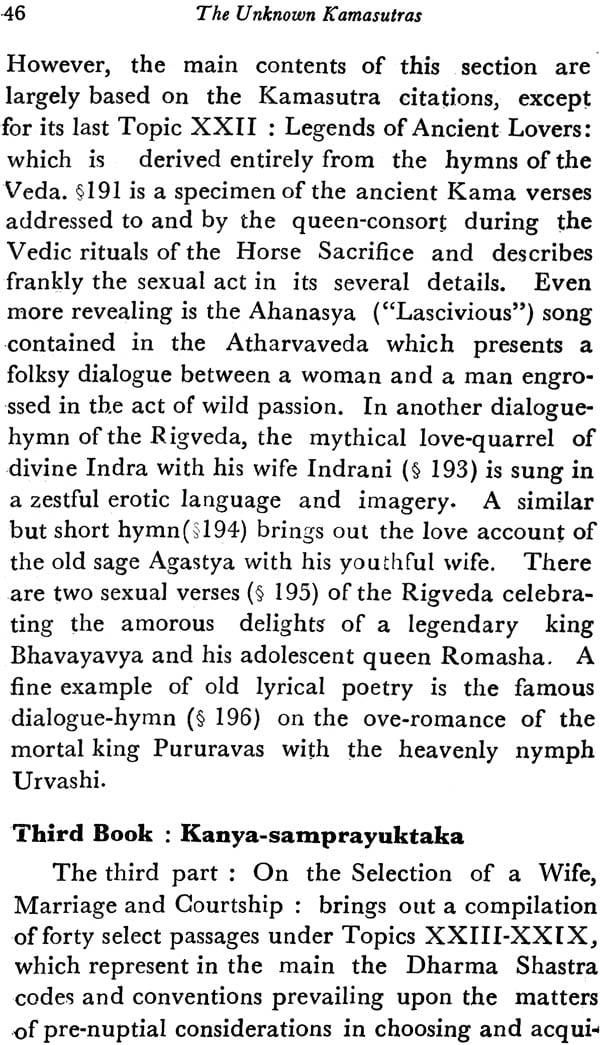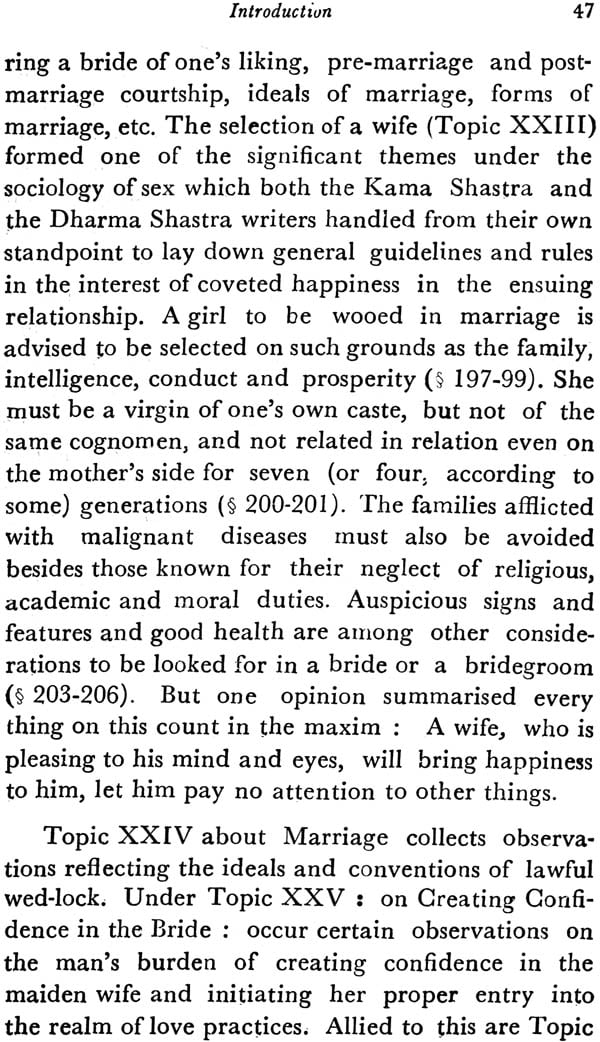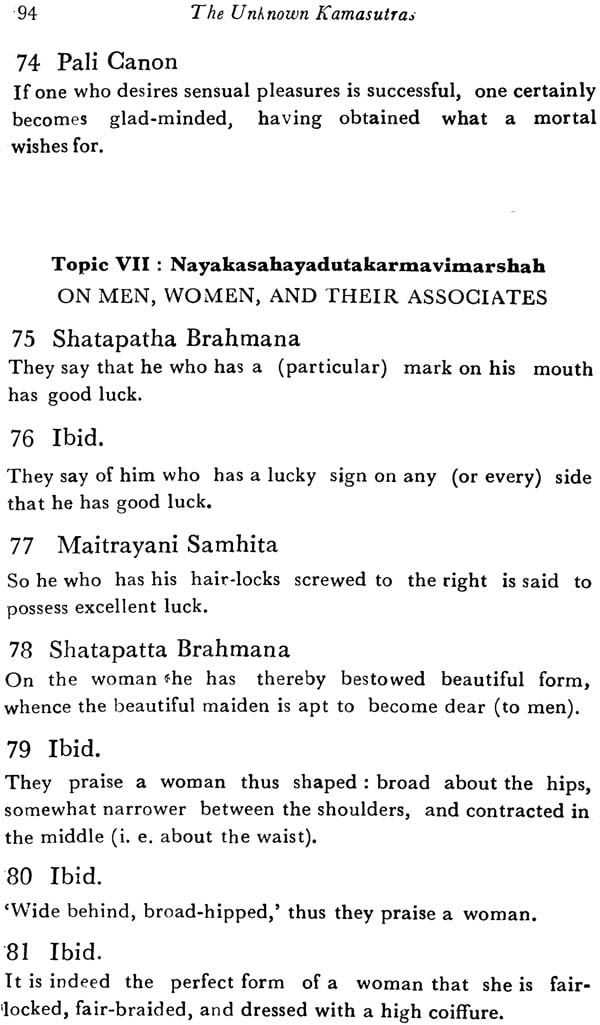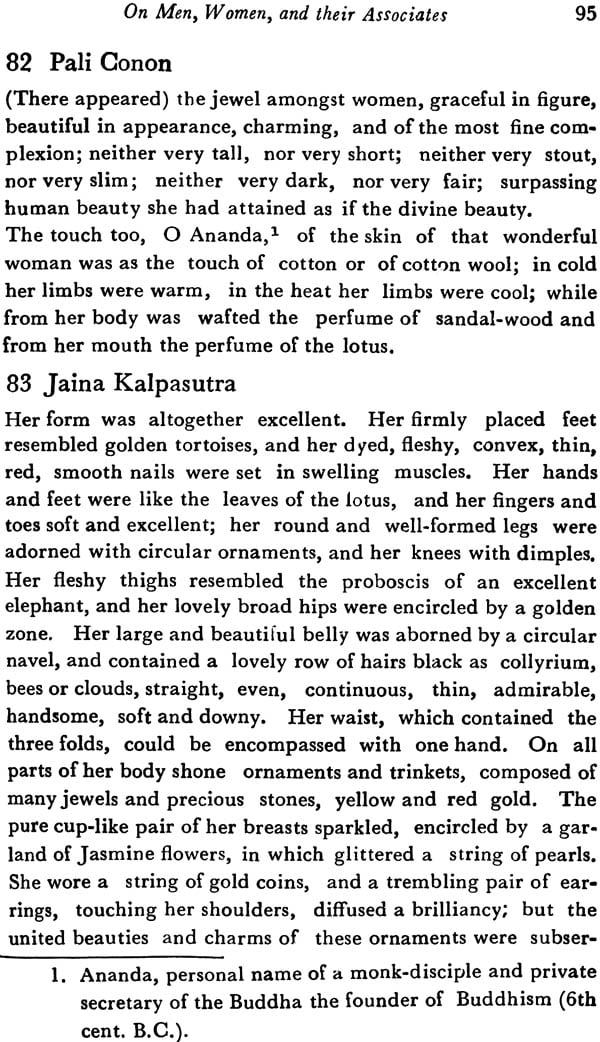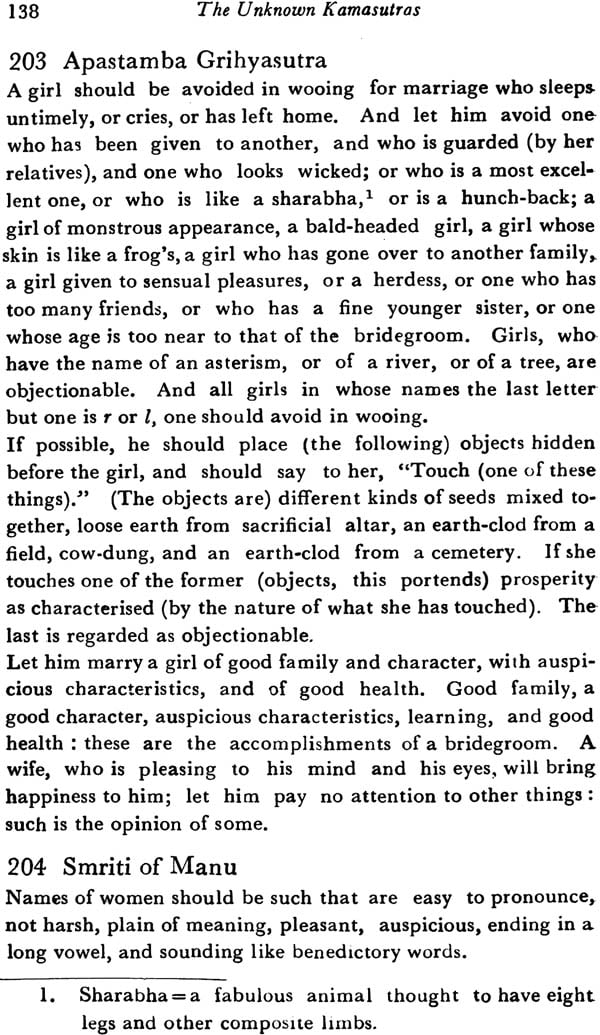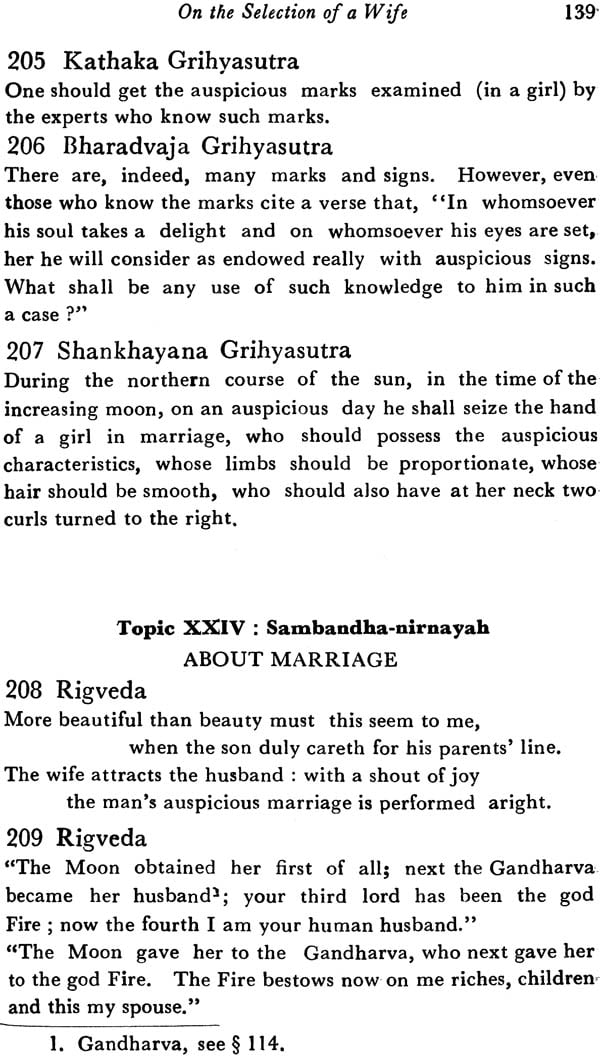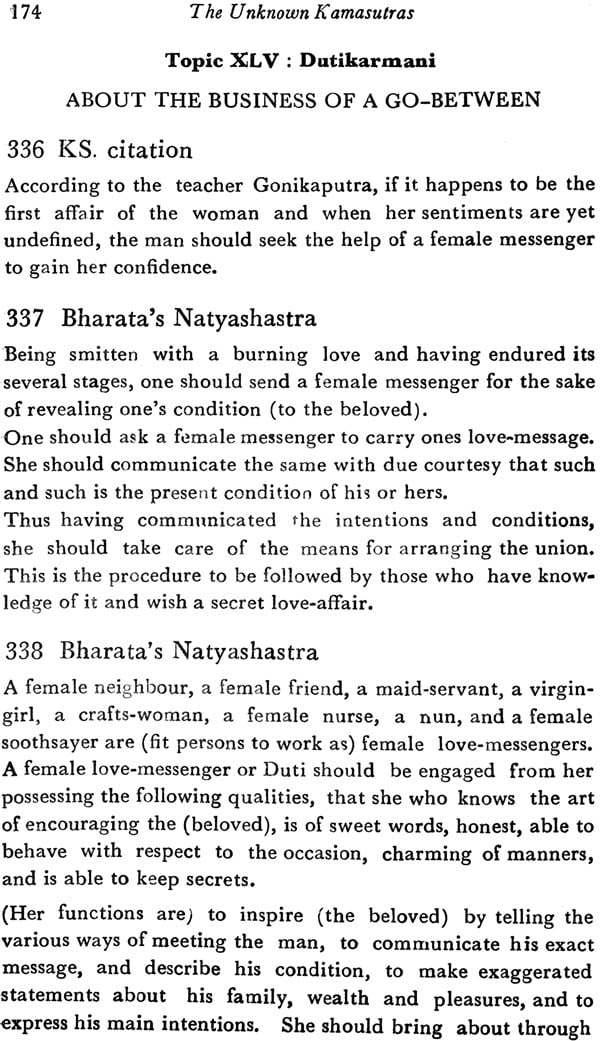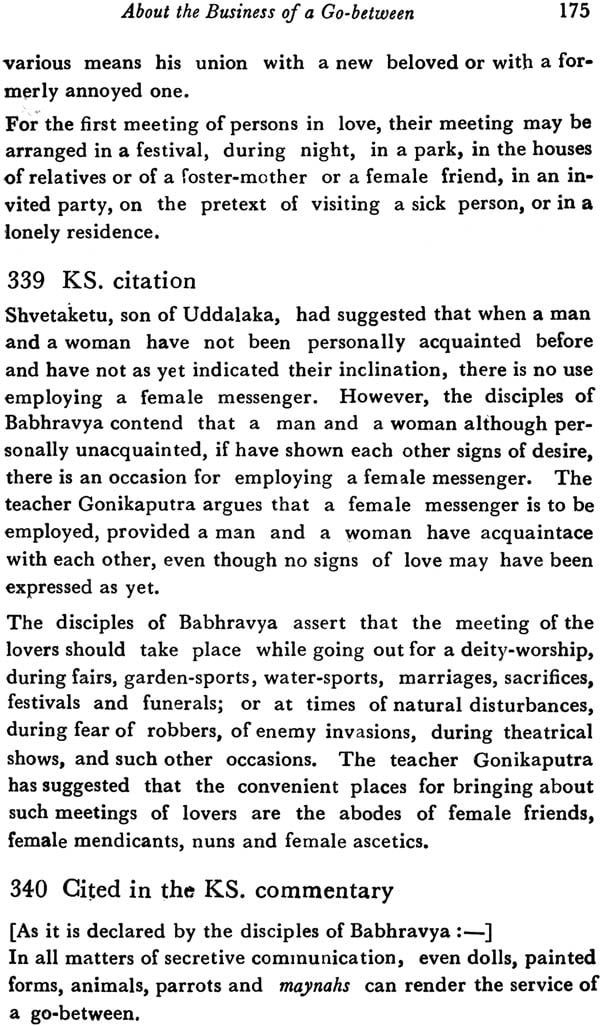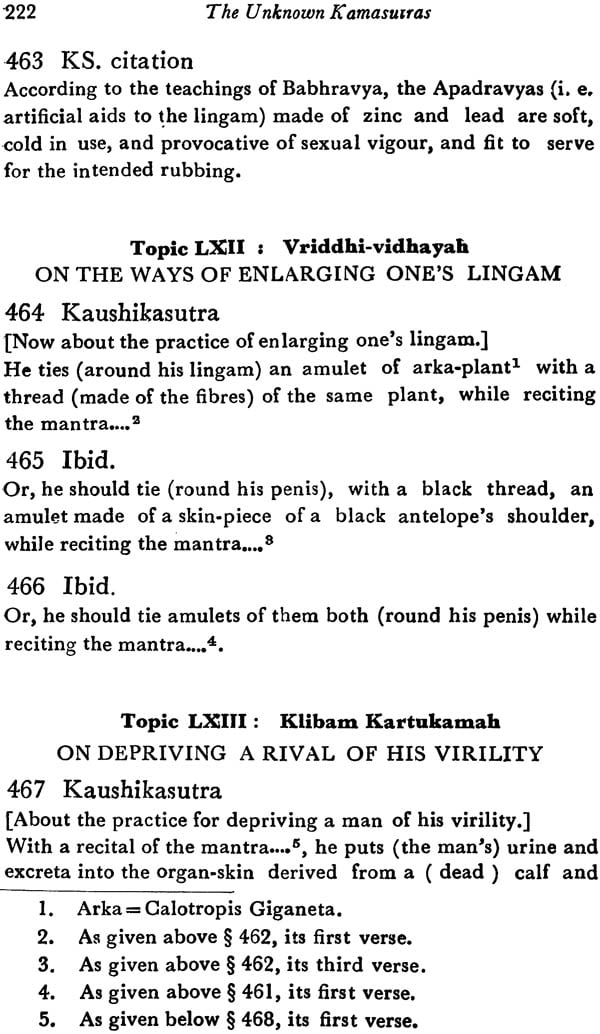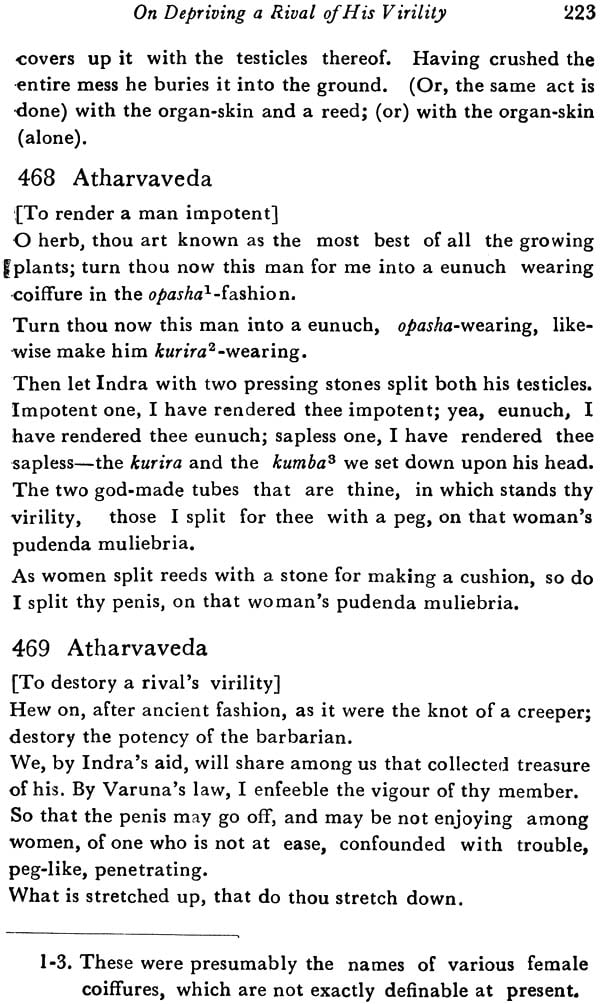
THE UNKNOWN KAMASUTRAS
Book Specification
| Item Code: | IDD708 |
| Author: | Prithvi K. Agrawala |
| Publisher: | BOOKS ASIA |
| Language: | English |
| Edition: | 1983 |
| Pages: | 248 |
| Cover: | Paperback |
| Other Details | 8.6" X 5.6" |
| Weight | 400 gm |
Book Description
This outstanding anthology presents for the first time both to the scholars and general readers a companion volume to the famous Kamasutra by the sage-teacher Vatsyayana. The present compendium will be found to serve as veritable source-book of original views and teaching belonging historically to pre-Vatsyayana authorities which -as arranged here systematically under the Sixty-four conventional topic of the Kama Shastra -open a new tract of ancient wisdom, exposing the Aphorisms of Love hitherto lost and unknown. It goes to retrieve many a canonical and epic text in specific perspective of the old Kama Shastra India's literary history, beginning from the oldest Vedas down to the poetic and technical documents of the second century at the latest.
Kama is just one integral aspect of the age-old socio-religious philosophy of Three Human Pursuits, viewing man's three-sided prism-personality as a harmonious aggregate of Dharma-Artha-Kama-Virtue-Wealth-Desire. This indeed interpreted the practices of love of Kama as an essential means of attaining the fulfillment of married life in its fuller worldly joys and day-to-day affairs as well as socially attendant dutie sand moral function.
Dr. P.K. Agrawala is a well- known scholar of Indology working as a University Professor in the Department of Ancient Indian History, culture & Archaeology of the Banaras Hindu University, Varanasi. His special field of investigation is Ancient Indian Art, Iconography and Religious thought.
Argument
Kama is one of the most profound notions of the Sanskrit Culture which India evolved as the life-pattern of her people, devoted to an enlightened pursuit of institutionalised achievements along the way of their continued striving for human perfection. The momentum of love is the very source of life on this earth. Being the elemental force ever conditioning man’s multi-faceted reflexes of consciousness, it is Kama that has moulded and defined the routes of all refined patterns and cultured spontaneities of his innate nature far beyond the animal rudiments. The word Kama is derived from the root kam: (1) to love; (2) to desire or wish; (3) to have sexual intercourse with. And as an abstract noun the word has these root-meaning according to the context. When a primary principle of psyche, Kama is the activity of the mind to comprehend or possess anything on the thought level. But as a combined psychophysiological function Kama is normally understood in its sex-centered connotation referring to one’s whole personality as coming in union with another personality of opposite sexual definition.
Sex is nature’s pre-eminent phenomenon providing the foundation of family and social life. An unending search for the ordered structure of sexual behavior has been a rudimentary fact of all socio-religious evolution of human culture form the most primitive to the most civilized stages of its existence. Sex is the predominant factor as also posing itself against its own orderly manifestation, and the vastly yet innocent realm of desire is ruled by its unknown mysteries arising in man’s sex practices and procreative involvement have been more or less the same since time immemorial. The human societies whether less civilised or far advanced have always looked for solution into incantational usages of magical beliefs and allied mysterious techniques besides things rooted in medicinal cures and remedies. As early as the Vedic Samhitas, which represent the most antique stratifications of Aryan literature, we find a comprehensive assortment of live enchantments and magical sex-rites assiduously compiled and incorporated as part of the most authoritative matters of religion and esoteric discipline. Already during the time of the Rigveda collection, marriage was made into a religion duty and the ideals of a happy and successful life marriage were recognised as of primary moral and social necessity (see. 208-9, 237-8).
The Atharvavedic collection enjoys a unique place in the Vedic lore for its main concern with matters belonging to the broader current of popular customs and folk beliefs rooted in household rituals, family charms and allied hocus-pocus rather than the main current of hieratic religion and sacer-dotalism of exalted priestly footing. Both magic and mysticism go hand in hand in the more realistic picture of the common society that is reflected in this old theological anthology. Besides things connected directly with demonology and sorcery, other different themes concerning the life in priesthood, royalty and similar public functions, medicinal charms for gaining health, healing of diseases, spells to obtain prosperity and eminence, etc., we have also the specific Kama material contained in the work which may be found to form its almost one-tenth portion. This largely consists of the charms pertaining to women-Stri-karmani-as they are traditionally designated, showing the fact that the eventful life of women before, during and after marriage had its wide range of interests, duties and kindred worries to be properly attended to for the harmonious upkeep and well-being of the household love-life. This further explicates the scope and character of the earliest Kama tradition that devoted its specialised study not to the curiosities and practices of sexual union alone but also to the compelling duties and rather unromantic aspects of conjugal life in general. It can be fairly assumed from the varied themes of the women’s charms and magical formulas contained in the Atharvavedic book, that the scope and comprehensive character of the Kama teachings, as approached and understood in that age, covered all such notions and interests as the invocation of the Love-god Kama for favouring with a successful love-life, wooing and winning a girl’s heart, winning a man’s love, obtaining a wife, getting a husband for a woman, wedding rites and ceremonies, holy performances connected with fecundation, pregnancy and child-birth, ensuring the birth of male children, matrimonial happiness, gaining of virility, obviating of sterility in a women, allaying of conjugal jealousy, effecting of discomfiture or destruction of rivals in love, destroying of one’s virility, effecting of spinterhood in a women, gaining of superior position over a rival women or co-wife, causing of harms to a rival women, gaining of control over the husband, subjugation of the wife, robbing of another’s attractiveness, recovery of one’s attractiveness and luck in love, quenching of the love’s heart-burning, sleeping-charm preparatory to an assignation, treating of a women’s evil bodily marks, etc. (see 408ff.). There can be no doubt that this old Vedic lore on love recipes and rituals was the authoritative stuff utilized and thoroughly worked up in the later tradition and it is not strange that even such classical writing on erotics as Vatsyayana have directly invoked for their authority in this context the teachings of the Atharvaveda or simply the Veda, by which this particular Vedic school is basically meant.
- Introduction
- Contents of the Treatise 65-69
- On the Origins of Science of Erotics 69-70
- On the Three Aims of Human life 71-81
- Gkorification of Kama 81-85
- On the Study of the Various Arts 85-90
- The Daily Life of Citizen 90-94
- On Men, Women and their Associates94-100
Section two: On Sexual Union (Samprayogikam)
- General Observations on Sexual Union 101-09
- Kinds of Union according to Dimensions, Intensity and Duration 109-13
- The Different Kinds of Love 113-14
- On the Embrace 114-15
- On Kissing 115-16
- On Nail-marks 116
- On Teeth-marks 117
- On Postures of Union 118-20
- On the Various Ways of Striking Blows 120-21
- On the Sounds Associated with Striking 121
- On Women Assuming the Man's Role 121-35
- On the Mouth Congress 123
- On the Beginning and Ending of Congress 123-24
- Legends of Ancient Lovers 124-35
Section Three: Selecting a Wife, Marriage and Courtship (Kanyasamprayuktakam) 136-148
- On the Selection of a Wife 136-39
- About Marriage 139-41
- On creating Confidence in the Bride 141-42
- On Coutship and the Expression of Feelings by outward Signs and Deeds 142-43
- On Things to be Done by a Man and the Acquisition of a Girl Thereby 143-45
- On the Ten Stages of Love
- Forms of Marriage
Section Four : On One's Own Wife (Bharyadhikarikam)
- Glorification of the Wife 149-51
- On the Conduct of a Virtuous Wife 151-54
- A Virtuous Wife's Behaviour during the Absence of her Husband 151-56
- Type of Wives 156-57
- On the Conduct of Co-wives 157
- On the Conduct of Remarried Woman 158
- About the Wicked Wives 158-63
- On the Women in the King's Harem 163-64
- On the Conduct of a Husband toward his wife 164-67
- On the Conduct of Husband who has more than one Wife 167-68
Section Five : On the Wives of Other Men (Paradarikam)
- On Determining the Conduct of Men and Women 169
- The Reason why Women Reject the Addresses of Men 170
- About Men who have Success with Women 170-71
- About Makng Acquaintance with the Woman and the Efforts to Win her over 171-73
- Examination of the Status of a Woman's Mind 173
- About the Business of a Go-between 174-75
- On the Ways of Protecting One's Own Wife 176
- About the Nature of Women 176-82
Section Six : About Courtesans (Vaishikam)
- On the Nature of Courtesans 183-84
- On the Courtesan's Associates, Customers, and the Cause of Her Resorting to Men 184-88
- On the Seductive Ways of Courtesans 188-191
- On the Ways of Getting Money 192-93
- On the Different Kinds of Gain 193-94
- On the Pecuniary Gains, Losses and Doubtful Cases 194-95
- Type of Courtesans 195-96
- About the State Control over Courtesans 196-99
Section Seven : On the Hidden Ways of Love-charms, Tonic Recipes and the like (Aupanishadikam)
- Charms for Procuring a Wife 200-01
- Charms for Procuring a Husband 201-02
- On Bringing Martial Luck to Himselft 203-04
- On Subjugating the Hearts of Others 205-216
- On Tonic Recipes 216-19
- On Regaining One's Lost Virility 219-222
- On the Ways of Enlarging One's Lingam 222
- On Depriving a Rival of his Virility 222-23
- Miscellaneous Experiments, Charms and Recipes 224-48
Argument1-4, Approach 4-8; Vatsyayana's Kamasutra 8-18; Pre-Vatsyayana Tradition 10-14; Great Historical Sage Shvetaketu 14-17; the Panchala Country: Shevtaketu and Babhravya 17-19; Shvetaketu's Views 19-21; Babhravya's Shastra 22-24; Mythical Nandi 24; Post-Babhravya Teachers: Dattaka 24-26; Charayana 26-27; Suvarnanabha's Views 27; Ghotakamukha and Others 27-28; Kuchumara 28-29; Sixty-four Topics 29-30; Kamasutras 31-32; Our pre Vatsyayana Source 32-35; First Book: General Principles 35-41; Second Book: On Sexual Union 41-46; Third Book:Kanya-samprayuktaka 46-48; Fourth Book: On One's Own Wife 48-52; Fifth Book: Paradarikam 52-55; Sixth Book: About Courtesans 55-59; Seventh Book : Hidden Ways 59-63 Section One : General Principles (Sadharanam)
